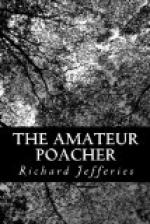Three copper wires twisted tight formed the snare itself; we twisted them like the strands of a rope, thinking it would give more strength. The wire projected horizontally, the loop curling downwards. It was first set up at a spot where a very broad and much-worn run—more like a footpath than a rabbit track—forked into several lesser runs, and at about five yards from the hedge. But though adjusted, as we thought, with the utmost nicety, no rabbit would put his neck into it—not even in the darkness of the night. By day they all played round it in perfect safety.
After waiting some time it was removed and reset just over a hole—the loop close to the opening. It looked scarcely possible for a rabbit to creep out without being caught, the loop being enlarged to correspond with the mouth of the hole. For a while it seemed as if the rabbits declined to use the hole at all; presently, however, the loop was pushed back, showing that one must have got his nose between it and the bank and so made a safe passage sideways. A run that crossed the field was then selected, and the wire erected at about the middle of it, equidistant from either hedge. Near the entrance of the buries the rabbits moved slowly, sniffing their way along and pausing every yard or so. But they often increased their speed farther away, and sometimes raced from one mound to the other. When going at that rate it appeared natural to conclude that they would be less careful to pick and choose their road.
The theory proved so far correct that next day the upright was down, but the wire had snapped and the rabbit was gone. The character of the fracture clearly indicated how it had happened: the rabbit, so soon as he found his head in the noose, had rolled and tumbled till the wire, already twisted tight, parted. Too much twisting, therefore, weakened instead of strengthening. Next a single wire, somewhat thicker, was used, and set up nearly in the same place; but it broke again.
Finally, two strands of medium size, placed side by side, but only twisted once—that is, just enough to keep them together—were employed. The lesser loop—the slip-knot, as it might be called—was at the same time eased in order to run quicker and take a closer grip. Experiments with the hand proved that this style of wire would bear a great strain, and immediately answered to a sudden jerk. The running noose slipped the more easily because the wires were smooth; when twisted the strands checked the noose, the friction causing a slight sound. The wire itself seemed nearly perfect; but still no rabbit was caught.
Various runs were tried in succession; the size of the loop, too, was now enlarged and now decreased; for once it seemed as if a rabbit’s ears had struck it aside, and on another as if, the loop being too large or too low down, one of the fore feet had entered and drawn it. Had it been the hind leg the noose would have held, because of the crook of the leg; but the fore foot came through, leaving the noose drawn up to a size not much larger than a finger-ring. To decide the point accurately, a full-grown rabbit was shot, and Orion held it in a position as near as possible to that taken in running, while I adjusted the wire to fit exactly. Still no success.




